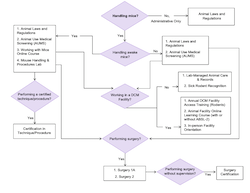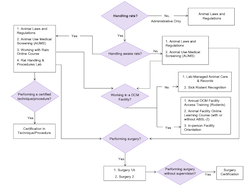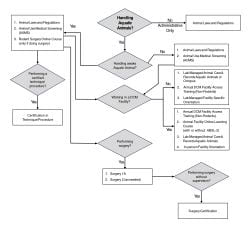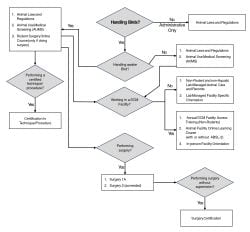Listed below are the training requirements personnel need to complete in order to work with animals at the University of Washington.
For a full listing of the Training Program’s course offerings, please visit the Online Courses, Hands-on Courses, and Facility Orientations pages.
To view your training record, please visit HoverBoard or My Research Training Transcript.
The following trainings and requirements are required for everyone working with animals:
Animal Use Laws and Regulations Training (Online)
This training must be updated every 5 years.
Animal Use Medical Screening (AUMS)
Screening needs to be updated as per the OHN’s recommendations. Please reference the instructions listed on the EH&S website for further information.
The following trainings and requirements are required for administrative personnel on protocols that are not working with animals:
Animal Use Laws and Regulations Training (Online)
This training must be updated every 5 years.
Expired Substances
The use of expired medical materials is prohibited in any survival procedure performed on live vertebrate animals used for research or teaching. ALL individuals attached to a protocol or in an animal care position must complete this lesson every three years.
Approval on your IACUC protocol in HoverBoard.
Have your PI or PI proxy submit an amendment to add you to the protocol.
Hands-On Laboratories
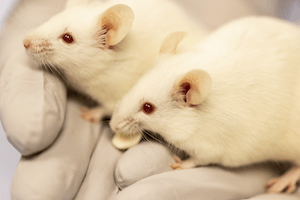
Individuals who will be handling or performing procedures on awake rodents, ferrets, rabbits, hamsters, guinea pigs, gerbils, pigs, sheep or dogs must complete the appropriate training class(es) before beginning work with each species. Such personnel must have completed or be registered for the appropriate species-specific training class before being added to a protocol.
Mice:
Working with Mice at the UW
The PI is also required to complete the course even if they are not personally working with mice.
Mouse Hands-on Laboratory Required for individuals working with mice.
Prerequisite: online “Working with Mice at the UW” course.
Rats:
Working with Rats at the UW
The PI is also required to complete the course even if they are not personally working with rats.
Rat Hands-on Laboratory Required for individuals working with rats.
Prerequisite: online “Working with Rats at the UW” course.
Other Species (required if working with the species, but there are no prerequisites):
Guinea Pig Hands-on Laboratory
Spiny Mouse Hands-on Laboratory
Note: Personnel who are working with, or who have worked with, rabbits, dogs, ferrets or pigs at the UW prior to the time of adoption of this policy (May 17, 2012) are exempt from the requirement to complete the rabbit, dog, ferret or pig training class, respectively.
Individuals performing the following procedures/techniques in the species will be required to obtain a certification prior to performing it in animals.
Mice:
- Cervical dislocation (anesthetized or unanesthetized)
- Retro-orbital bleeding (anesthetized or unanesthetized)
- Retro-orbital injections (performed on anesthetized mice only)
- Decapitation on adult mice >14 days old (unanesthetized)
- Tape skirt
Rats:
- Decapitation on adult rats >14 days old (unanesthetized)
Fish:
- Stunning followed by caudal tail vein severing
- Stunning followed by gill severing
- Stunning followed by decapitation
- Stunning followed by pithing
- Carbon dioxide (CO2) euthanasia
- Decapitation (unanesthetized)
Amphibians (for appropriate species only):
- Pithing
Birds:
- Decapitation (unanesthetized)
- Cervical dislocation (unanesthetized)
Rabbits:
- Decapitation (unanesthetized)
- Penetrating captive bolt pistol performed only on rabbits > 2 Kg
- Cervical dislocation performed only on rabbits < 1 Kg (anesthetized or unanesthetized)
Guinea Pigs:
- Decapitation (unanesthetized)
Hamsters:
- Decapitation (unanesthetized)
- Retro-orbital bleeding (anesthetized or unanesthetized)
Gerbils:
- Decapitation (unanesthetized)
- Retro-orbital bleeding (anesthetized or unanesthetized)
- Retro-orbital injections (performed on anesthetized gerbils only)
Spiny Mice:
- Cervical Dislocation (anesthetized)
USDA-Covered Species:
- Anesthesia
- Sedation
- Paralytic Administration
- Refer to the IACUC Policy for more information
All Species:
- Surgery
- Refer to the IACUC Policy for more information
For individuals performing aseptic animal surgery for the first time at the UW, as well as UW personnel performing aseptic surgery on a new category of animal (rodents; USDA-covered non-rodents; other animals) must complete the online and in-person surgery courses. Survival surgeries must be approved on the protocol prior to enrollment.
| Required Training for Individuals Performing Aseptic Surgery |
|---|
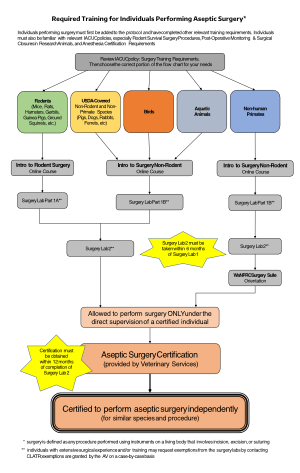 |
Rodent users
For individuals working with mice, rats, gerbils, hamsters, guinea pigs, etc., the following is required:
Introduction to Rodent Surgery – online course
Surgery Laboratory Part 1A
Prerequisite: online “Introduction to Rodent Surgery” course.
Surgery Laboratory Part 2
Prerequisite: Surgery Laboratory Part 1A.
Supervised Surgery Experience All individuals must obtain supervised surgery experience within their lab by trained IACUC protocol staff in protocol-approved surgery location(s) until the individual is ready for certification.
Prerequisite: Surgery Laboratory Part 2.
Aseptic Surgery Certification An individual performing aseptic surgery independently must obtain a surgery certification. This involves an on-site observation by the Attending Veterinarian or a designee. Based on the on-site observation, the individual is either certified to perform aseptic surgery independently or the individual is required to have additional training in specific aspects of surgery before certification is granted.
Prerequisite: Supervised Surgery Experience.
USDA-Covered, Non-Rodent users
For individuals working with bats, rabbits, cats, ruminants, dogs, pigs, ferrets, non-human primates, etc., the following is required:
Introduction to Surgery (Non-Rodent, USDA-Covered Animals) – online course
Surgery Laboratory Part 1B
Prerequisite: online “Introduction to Surgery (Non-Rodent, USDA-Covered Animals)” course.
Surgery Laboratory Part 2
Prerequisite: Surgery Lab Part 1B.
Supervised Surgery Experience – All individuals must obtain supervised surgery experience within their lab by trained IACUC protocol staff in protocol-approved surgery location(s) until the individual is ready for certification.
Prerequisite: Surgery Laboratory Part 2.
Aseptic Surgery Certification – An individual performing aseptic surgery independently must obtain a surgery certification. This involves an on-site observation by the Attending Veterinarian or a designee. Based on the on-site observation, the individual is either certified to perform aseptic surgery independently or the individual is required to have additional training in specific aspects of surgery before certification is granted.
Prerequisite: Supervised Surgery Experience.
Other species (e.g., fish, frogs, birds, etc.):
Course requirements are determined on a case-by-case basis.
Supervised Surgery Experience – All individuals must obtain supervised surgery experience within their lab by trained IACUC protocol staff in protocol-approved surgery location(s) until the individual is ready for certification.
Aseptic Surgery Certification – An individual performing aseptic surgery independently must obtain a surgery certification. This involves an on-site observation by the Attending Veterinarian or a designee. Based on the on-site observation, the individual is either certified to perform aseptic surgery independently or the individual is required to have additional training in specific aspects of surgery before certification is granted.
Prerequisite: Supervised Surgery Experience.
Exceptions:
Extensive surgery experience: If you are a surgeon (MD, DVM) and would like to petition out of the laboratory classes, please email clatr@uw.edu.
USDA-covered non-rodent users: Personnel assisting with surgery in an OR in Comparative Medicine with a veterinarian/vet tech looking over their shoulder may be exempted from the online and laboratory classes. If this exception applies to you, please email clatr@uw.edu.
Bat, rabbit, cat, ruminant, dog, pig, ferret users: Medical students who are receiving aseptic surgery instruction as part of their schooling may be exempted from the online and laboratory classes. If this exemption applies to you, please email clatr@uw.edu.
For individuals working within Department of Comparative Medicine (DCM) animal facilities:
Annual DCM Facility Access Training (Rodent) Required on an annual basis if you are a rodent user.
Annual DCM Facility Access Training (Non-Rodent) Required on an annual basis if you are a non-rodent user.
Please note: The non-rodent version of the form is required for those working only with non-rodent species. If you have already completed the rodent version of the course, and you also work with non-rodents, you do not have to complete the non-rodent version of the form. However, if you have only completed the non-rodent version of the course, but are now working with rodent species, you are required to complete the rodent version of the course.
Animal Facility Online Learning Course (with/without ABSL-2)Required for all facility orientations.
Personnel working in an ABSL-2 room do not need to take the “without ABSL-2” version, but need to complete the “with ABSL-2” version instead.
Animal Facility Orientation Required for individuals (both rodent and non-rodent users) who need entry approval for DCM facilities.Prerequisites:
- Personnel must be approved on a UW protocol,
- Annual DCM Facility Access Training (Rodent/Non-Rodent),
- Animal Facility Online Learning Course (with/without ABSL-2).
Animal Bio-Safety Level 2 or 3 Room Orientation Required for individuals that will work in Animal Bio-Safety Level 2 or 3 rooms within DCM facilities.
Prerequisites:
- Animal Facility Orientation
- Animal Facility Online Learning Course (with ABSL-2).
Behavior Room Orientation Required for individuals who will work in behavior study rooms within DCM facilities.
Prerequisite: Animal Facility Orientation.
Gnotobiotic Animal Core (GNAC) Orientation Required for individuals who will work in the Gnotobiotic Animal Core (GNAC).
Prerequisite: Animal Facility Orientation.
Required for individuals who provide husbandry and care for their own animals in laboratory-managed animal facilities (i.e, husbandry not provided by the Department of Comparative Medicine).
The PI or a professional staff lab manager is also required to complete these relevant class.
Lab-Managed Animal Care and Records: Aquatic Animals
Lab-Managed Animal Care and Records: Octopus
Lab-Managed Animal Care and Records class and Sick Rodent Recognition class
(Note: these classes are offered back-to-back).
Non-Rodent and non-Acquatic Lab-Managed Animal Care and Records
